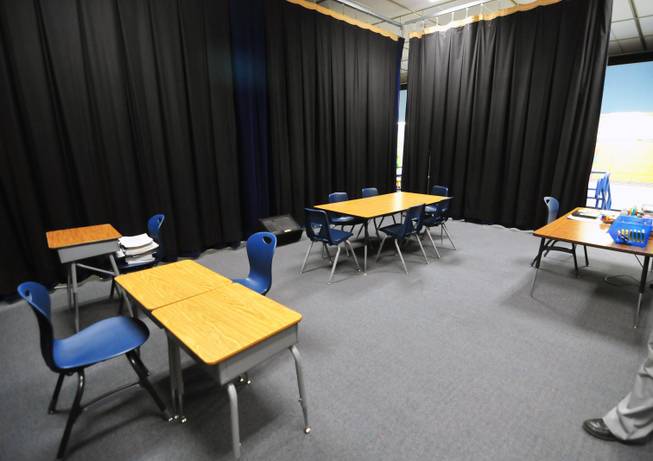
Ronzone Elementary School, located in the central Las Vegas Valley, has 20 portable classrooms and uses the backstage section of its central auditorium as a classroom for high-achieving students. Across the district, there are more than 1,200 portable classrooms serving about a fifth of all elementary school children.
Tuesday, Feb. 11, 2014 | 2 a.m.
Nevada fails to provide adequate school funding to poor children, according to a national report.
Every two years, the Education Law Center publishes a report card that grades states on how fairly they distribute per-pupil funding to schools.
Education researchers at Rutgers University in New Jersey looked at several indicators to determine whether a state provides school funding fairly. These indicators ranged from how much state and local tax revenue is devoted to education to how much school funding goes to poor children.
Nevada received an overall grade of “F,” based on Rutgers researchers’ analysis. Here’s how Nevada fared on the major indicators:
-
1. Level of per-pupil funding:
There is some debate over whether higher school funding translates to better test scores and graduation rates. However, Rutgers researchers argue that states must provide a sufficient level of funding so that all students — no matter their socioeconomic status — have the opportunity to learn in school.
Nevada ranks 37th nationally in education funding, spending $8,719 per student in 2011 — up $573 from 2007.
Nationally, the average per-pupil spending was $10,658 in 2011, according to the National Center for Education Statistics.
Wyoming spends the most on schools — $17,397 per student — while Idaho spends the least — $6,753 per student.
Researchers used estimated per-pupil figures that were adjusted for differences in regional wages, poverty and population density.
-
2. School funding distribution:
While the Silver State has increased its school spending, the Education Law Center criticized Nevada for not distributing enough money to students who need it most: children from low-income families.
Poor children require more resources to educate and mitigate the economic disadvantages at home. A “fair” school funding formula is one that allots more money to high-poverty schools, according to Rutgers researchers.
Nevada received an “F” grade — last in the nation — for having a regressive school funding formula. Researchers estimated that wealthier Nevada school districts received $11,145 per pupil while poorer districts received $7,712 per pupil — a difference of more than $3,400.
This disparity in funding affects student-teacher ratios. Wealthier schools can afford lower student-to-teacher ratios while poorer schools cram more students into classrooms, researchers found.
Researchers projected that wealthy Nevada schools had student-teacher ratios of 15-to-1. At poor Nevada schools, student-teacher ratios were estimated around 21-to-1.
Nevada was among 19 states nationally that had a regressive school funding formula. Rutgers researchers penalized Nevada for having a regressive funding distribution system, but also low per-pupil spending.
Nationally, Minnesota had the most progressive school funding formula, whereby school districts with poorer students received more money than districts with wealthier students.
-
3. Education spending, as a percentage of economic output:
Some states place a greater emphasis on education than others. Researchers determine this by looking at states’ education spending as a percentage of its overall economic output.
Nevada received an “F” grade for its spending on schools in relation to its overall economic output, known as Gross Domestic Product.
Each Nevadan produced on average $40,970 in goods and services in 2011. About 2.8 percent of the GDP per capita went to education.
In Vermont, which received an “A” grade and the top ranking nationally, 5.5 percent of its GDP per capita went to schools.
Despite being devastated by the Great Recession, Nevada maintained a stable ratio of education spending as a percentage of its overall economic wealth.
-
4. The share and economic status of students attending public schools:
The more students there are in the public school system, the greater the need for a fair school funding formula, according to researchers.
About 92 percent of Nevada children ages 6 to 16 attend public schools. Nationally, public school attendance ranges from 78 percent in Hawaii to 94 percent in Utah.
Researchers also looked at the economic status of students in public and private schools. The greater the disparity, the harder it is to create a fair school funding system that drives more funds to poorer students, researchers said.
Nevada has the 12th largest income gap between students in the public and private schools.
The median household income for public school students is $68,988. On the other hand, the median household income for private school students is $121,141.
-
5. Other factors:
Research shows that high quality preschool programs can give poor students a leg up in school.
However, Nevada has the lowest preschool enrollment rate nationally: 29 percent. Nevada also has the lowest enrollment rate among low-income children: 21 percent.
Washington, D.C., has the highest preschool participation rate nationally at 65 percent.

Join the Discussion:
Check this out for a full explanation of our conversion to the LiveFyre commenting system and instructions on how to sign up for an account.
Full comments policy